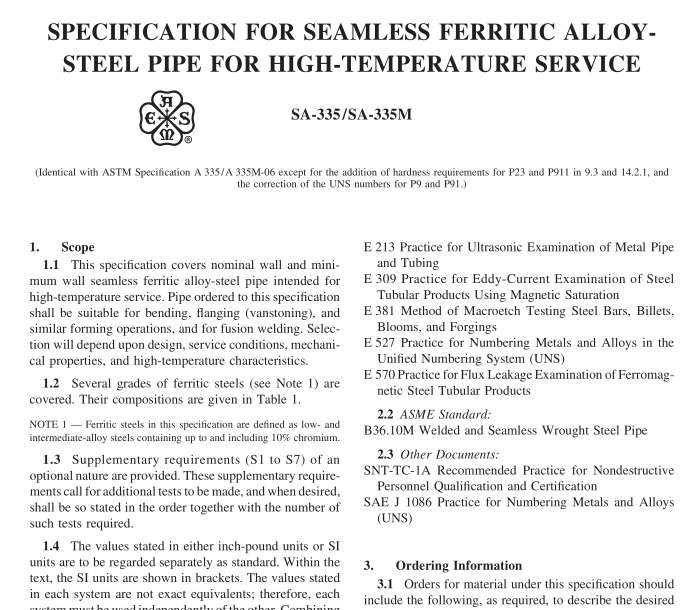ASME SA335:2013 pdf free download SPECIFICATION FOR SEAMLESS FERRIITIC ALLOY-STEEL PIPE FOR HIGH-TEMPERATURE SERVICE
13.2The following information is for the benefit ofthe user of this specification:
13.2.1 The reference standards defined in 13.8 areconvenient standards for standardization of nondestructiveexamination equipment. The dimensions of these standardsshould not be construed as the minimum size imperfectiondetectable by such equipment.
13.2.2 Ultrasonic examination can be performed todetect both longitudinally and transversely oriented discon-tinuities. It should be recognized that different techniquesshould be employed to detect differently oriented imperfec-tions.The cxamination may not detect short,deep imper-fections.
13.2.3The eddy current examination referenced inthis specification has the capability to detect significantdiscontinuities,especially of the short abrupt type.
13.2.4 The flux leakage examination referred to inthis specification is capable of detecting the presence andlocation of significant longitudinally or transversely ori-ented discontinuities. It should be recognized that differenttechniques should be employed to detect differently ori-ented imperfections.
13.2.5 The hydrostatic test of Section 12 has thecapability to find imperfections of a size that permit thetest fluid to leak through the pipe wall so that it may beeither visually seen or detected by a loss of fluid pressure.This test may not detect very tight, through-wall imperfec-tions,or imperfections that extend into the wall withoutcomplete penetration.
13.2.6 A purchaser interested in ascertaining thenature (type,size, location, and orientation) of discontinu-ities that can be detected in the specific application of theseexaminations should discuss this with the manufacturer ofthe tubular products.
13.3 Time of Examination:
13.3.1 Nondestructive examination for specificationacceptance shall be performed after all mechanical pro-cessing, heat treatments and straightening operations. Thisrequirement does not preclude additional testing at earlierstages in the processing.
13.4 Surface Condition.s:
13.4.1All surfaces shall be clean and free of scale,dirt, grease,paint,or other foreign material that couldinterfere with interpretation of test results. The methods used for cleaning and preparing the surfaces for examina-tion shall not be detrimental to the base metal or the surfacefinish.
13.4.2 Excessive surface roughness or deep scratchescan produce signals that interfere with the test (see13.10.2.3).
13.5 Extent of Examination:
13.5.1 The relative motion of the pipe and the trans-ducer(s),coil(s).or sensor(s) shall be such that the entirepipe surface is scanned, except for end effects as noted in13.5.2.
13.5.2 The existence of end effects is recognized,and the extent of such effects shall be determined by themanufacturer.and.if requested,shall be reported to thepurchaser.Other nondestructive tests may be applied tothe end areas, subject to agreement between the purchaserand the manufacturer.
13.6 Operator Qualifications —The test unit operatorshall be certified in accordance with SNT-TC-1A,or anequivalent,recognized and documented standard.
13.7 Test Conditions:
13.7.1 For examination by the ultrasonic method,the minimum nominal transducer frequency shall be2.25 MHz.
13.7.2 For eddy current testing, the excitation coilfrequency shall be 10 kHz, or less.
13.8 Reference Standards:
13.8.1 Reference standards of convenient lengthshall be prepared from a length of pipe of the same grade,size (NPS or outside diameter and schedule or wall thick-ness), surface finish and heat treatment condition as thepipe to be examined.
13.8.2 For ultrasonic testing, the reference notchesshall be any one of the three common notch shapes shownin Practice E 213,at the option of the manufacturer.Thedepth of the notch shall not exceed 12!% of the specifiednominal wall thickness of the pipe or 0.004 in.(0.1 mm),whichever is greater. The length of the notch shall be atleast twice the diameter of the transducer(s).The width ofthe notch shall not exceed the depth.
13.8.3 For eddy current testing, the reference stan-dard shall contain,at the option of the manufacturer, anyone of the following discontinuities:
13.8.3.1 Drilled Hole — The reference standardshall contain three or more holes, equally spaced circumfer-entially around the pipe and longitudinally separated by asufficient distance to allow distinct identification of thesignal from each hole.The holes shall be drilled radiallyand completely through the pipe wall,with care beingtaken to avoid distortion of the pipe while drilling.The
ASME SA335:2013 pdf free download
